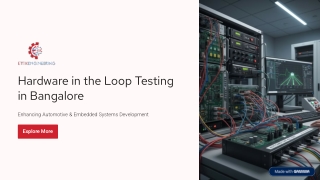
0 likes | 1 Views
Experience the future of test automation with Ettikengineeringu2019s hardware loop testing in Bangalore. Our HIL test systems are designed to deliver high accuracy, reliability, and seamless integration for embedded systems. know more at https://ettikengineering.com/automated-test-equipment-in-bangalore/<br>

E N D
Hardware in the Loop Testing in Bangalore Enhancing Automotive & Embedded Systems Development Explore More
What is Hardware in the Loop (HIL) Testing? Hardware in the Loop testing is a sophisticated validation technique that simulates real-world operating conditions for embedded systems. By creating a virtual environment that mimics actual vehicle behavior, HIL systems enable engineers to test electronic control units (ECUs) safely and comprehensively. This approach dramatically reduces development cycles while catching potential issues early before expensive physical prototypes are built. The result is faster time-to-market and significantly lower development costs.
Critical Role in Automotive Development Pre-Deployment Validation Scenario Simulation Safety Assurance Test ECU software thoroughly before integration into physical vehicles, eliminating costly post- production fixes Replicate thousands of driving conditions4from emergency braking to extreme weather4in a controlled lab environment Validate critical safety systems without risk to human testers or expensive prototype vehicles
HIL System Architecture A complete HIL system integrates multiple components working in perfect synchronization to create an accurate testing environment. Real-Time Simulator Device Under Test Processes vehicle models and environmental conditions at microsecond precision The actual ECU or embedded controller being validated I/O Interfaces Data Monitoring Signal conditioning hardware that bridges digital simulation with physical ECU connections Real-time visualization and logging of all test parameters and results
Key Advantages of HIL Testing 1 2 3 Cost-Effective Validation Enhanced Safety & Reliability Accelerated Development Cycles Eliminate the need for expensive physical test vehicles and reduce prototype iterations by up to 40% Test dangerous scenarios and edge cases that would be impossible or unsafe to replicate in real vehicles Run hundreds of test cases in parallel, 24/7, compressing months of testing into weeks No vehicle fleet maintenance costs Validate fail-safe mechanisms Automated regression testing Test fault injection scenarios Continuous integration support Minimal facility requirements Ensure regulatory compliance Rapid iteration capability Reusable test configurations
HIL Adoption in Bangalore's Automotive Ecosystem Bangalore has emerged as India's premier hub for automotive electronics and embedded systems development. Leading OEMs, Tier-1 suppliers, and innovative EV startups have established state-of-the-art HIL testing facilities across the city. Success Story: Multiple electric vehicle startups in Bangalore are leveraging HIL systems to validate battery management systems and motor controllers, reducing their development timelines by 6-8 months while ensuring world- class quality standards. 50+ 30% 2.5x Companies Using HIL Cost Reduction Faster Testing Across automotive and aerospace sectors Average savings in validation expenses Compared to traditional methods
Implementation Challenges High Initial Investment Complete HIL systems require significant capital expenditure for hardware, software licenses, and specialized infrastructure setup Specialized Expertise Required Engineers need deep knowledge of both embedded systems and real-time simulation to configure and operate HIL effectively Model Accuracy Concerns Simulation models must precisely replicate real-world physics and system behavior to ensure test validity Integration Complexity Connecting HIL systems with existing development toolchains and CI/CD pipelines requires careful planning
Innovative Solutions Emerging Modular HIL Architecture AI-Enhanced Testing Modern systems use scalable, modular designs that allow companies to start small and expand capacity as needs grow. This reduces upfront investment while maintaining upgrade flexibility. Machine learning algorithms optimize test case generation and automatically identify potential failure modes, dramatically improving test coverage efficiency. Standardized Frameworks Cloud-Based Simulation Industry consortiums are developing common interfaces and model formats, reducing integration effort and accelerating deployment timelines. Virtual HIL platforms are enabling remote testing and collaboration, with cloud computing power handling complex simulations without expensive on-premise hardware.
The Future of HIL in Bangalore 1 2024-2025: ADAS Validation Expanding HIL capabilities for Advanced Driver Assistance Systems testing as automotive companies scale up Level 2+ feature development 2 2026-2027: Autonomous Testing Next-generation HIL systems designed specifically for Level 4 autonomous vehicle validation, incorporating sensor fusion and scenario complexity 3 2028+: V2X Integration HIL platforms evolving to test vehicle-to-everything communication systems and smart city infrastructure integration
Key Takeaways 1 2 HIL is Essential Bangalore Leadership Hardware in the Loop testing has become indispensable for modern automotive and embedded systems development, particularly for safety-critical applications The city's robust ecosystem of automotive technology companies positions it as India's HIL testing hub with continued growth expected 3 4 Accessible Solutions Future Opportunities Modular architectures and cloud platforms are making HIL technology accessible to startups and mid-sized companies, not just large OEMs Autonomous vehicles, ADAS, and connected car technologies represent massive growth areas for HIL testing capabilities Visit our Website